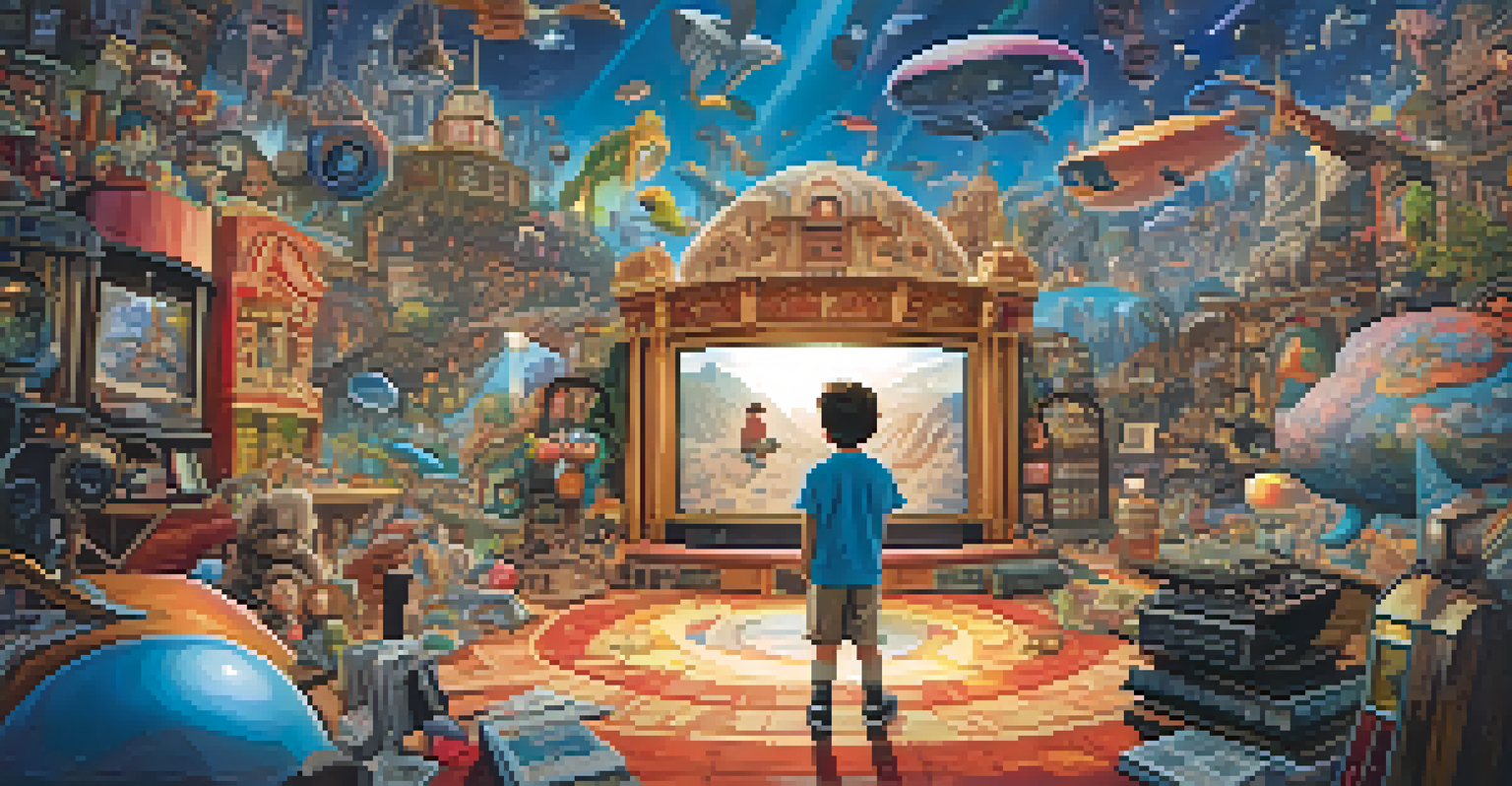Impact of Hollywood Blockbusters on Kids' Film Preferences

The Rise of Hollywood Blockbusters in Kids' Cinema
In recent years, Hollywood blockbusters have dominated the box office, especially films aimed at younger audiences. These high-budget productions often feature vibrant visuals, engaging storylines, and beloved characters, making them incredibly appealing to kids. As a result, children are increasingly gravitating towards these mainstream films over smaller, independent projects. This shift has changed the landscape of kids' cinema, with blockbusters often setting the bar for quality and entertainment.
Movies are a doorway into a world of imagination and creativity, and it's crucial for children to explore beyond the mainstream.
The marketing strategies employed by these studios play a significant role in attracting young viewers. From eye-catching trailers to extensive merchandise, children are not just introduced to these films; they are enveloped in a whole ecosystem designed to heighten their excitement. This creates a sense of familiarity and attachment even before they watch the movie. The result? A generation of kids who tend to favor these big-name films.
Moreover, the advent of streaming platforms has made it even easier for children to access these blockbusters. With just a click, kids can dive into the latest superhero saga or animated adventure, reinforcing their preferences. As they consume more of these films, their tastes are further molded by the narratives and characters that Hollywood consistently delivers.
How Blockbusters Influence Kids' Movie Tastes
The captivating stories and star-studded casts of Hollywood blockbusters significantly shape what children find appealing in films. Kids often develop a preference for fast-paced plots, colorful animation, and characters that they can relate to or aspire to be like. This means that smaller, less flashy films might struggle to capture their attention, even if they offer valuable lessons or unique storytelling.

Additionally, the themes explored in these blockbusters can heavily influence children's expectations regarding movie content. For instance, the prevalence of superhero movies has not only sparked interest but has also created a desire for similar narratives that emphasize adventure, bravery, and friendship. As a result, children may overlook films that focus on quieter, more introspective themes, which can be equally valuable.
Blockbusters Dominate Kids' Cinema
Hollywood blockbusters are increasingly preferred by children over independent films due to their engaging content and extensive marketing.
It's important to note that while blockbusters can introduce kids to exciting cinematic experiences, they can also limit their exposure to diverse storytelling. A narrow focus on mainstream films may prevent children from discovering the rich variety of genres and styles available in the world of cinema. This raises questions about the long-term impact on their tastes as they grow older.
The Role of Parental Influence on Film Choices
Parents play a crucial role in shaping their children's film preferences, often guiding them towards certain movies based on their own experiences or perceptions. Many parents find themselves gravitating towards Hollywood blockbusters, believing them to be safe choices due to their popularity and positive reviews. This can inadvertently lead children to develop a preference for these films, as they see them as a common ground for family movie nights.
Films can be a powerful tool for empathy and understanding, especially when they expose us to diverse narratives and cultures.
Moreover, parental choices are often influenced by marketing and social trends, making it easier to select films that are already widely accepted. When kids see their friends excited about the latest blockbuster, the desire to fit in can further push them toward those films. This cycle creates a reinforcing loop where both parents and children prioritize mainstream movies, sidelining potentially enriching independent films.
However, parents can also serve as a bridge to diversify their children's film experience by introducing them to lesser-known gems alongside the blockbusters. By balancing the cinematic diet, parents can nurture a more well-rounded appreciation for film that encompasses various genres, styles, and messages. This can help children develop a more expansive view of what movies can offer.
The Impact of Social Media on Kids' Film Preferences
Social media has transformed the way children discover and discuss films, particularly blockbusters. Platforms like Instagram, TikTok, and YouTube are flooded with trailers, reviews, and fan content, all dedicated to the latest Hollywood hits. This constant stream of information not only builds hype but also shapes what children perceive as 'must-see' movies, often overshadowing lesser-known films that might be equally enjoyable.
Children are particularly susceptible to the influence of their peers on social media, where trends can quickly emerge around specific films or characters. For example, viral challenges or fan art related to a blockbuster can create a snowball effect, prompting even more children to seek out those films. The result is a collective excitement that can overshadow personal preferences, making it challenging for kids to explore outside the mainstream.
Parental Influence Shapes Choices
Parents often guide their children's film preferences towards popular blockbusters, reinforcing mainstream tastes.
While social media can foster community and shared experiences around popular films, it can also perpetuate a herd mentality. Kids might feel compelled to watch a film simply because it is trending, rather than based on their own interests. This phenomenon raises concerns about how genuine their film preferences really are, as they may be guided more by external pressures than by personal taste.
The Educational Value of Non-Blockbuster Films
While Hollywood blockbusters are undeniably entertaining, they often lack the educational depth found in many independent or foreign films. These films frequently tackle complex themes and offer nuanced perspectives that can enrich a child's understanding of the world. For instance, movies that explore cultural differences or moral dilemmas can provide valuable life lessons that a typical action-packed blockbuster may overlook.
Unfortunately, the focus on blockbusters can lead to a missed opportunity for children to engage with diverse narratives that reflect different cultures and experiences. When kids are primarily exposed to mainstream films, they may develop a narrow worldview, limiting their ability to empathize with others. This is particularly concerning in an increasingly globalized society where understanding and appreciating diversity is crucial.
Encouraging children to watch a variety of films can enhance their critical thinking skills and foster a love for storytelling beyond the surface-level entertainment of blockbusters. Parents and educators alike have a role to play in promoting films that challenge children's perspectives and inspire curiosity about the world around them. This, in turn, can help cultivate more informed, compassionate future generations.
The Role of Film Festivals in Shaping Preferences
Film festivals dedicated to children's cinema have emerged as valuable platforms for showcasing independent and international films that often go unnoticed in mainstream media. These events not only provide exposure to a variety of genres but also create opportunities for young audiences to appreciate films that challenge conventional storytelling. By attending these festivals, children can be introduced to a broader range of films that expand their tastes.
Moreover, the interactive nature of film festivals often includes workshops and discussions that enhance the viewing experience. Children can engage with filmmakers, participate in Q&A sessions, and even create their own short films. This hands-on approach fosters a deeper appreciation for the art of filmmaking and encourages kids to explore stories that resonate with them personally, rather than just what is popular.
Diversity in Film is Crucial
Encouraging exposure to a variety of films can enhance children's understanding and appreciation of diverse narratives.
As more families attend these festivals, there is potential for a shift in film preferences as children become more aware of the diverse storytelling available to them. This can help counteract the overwhelming influence of Hollywood blockbusters and inspire kids to seek out unique narratives that may not fit the typical mold. Ultimately, film festivals can play a pivotal role in shaping a more diverse film landscape for future generations.
The Future of Kids' Film Preferences in a Changing Landscape
As the landscape of cinema continues to evolve, so too will children's film preferences. With the rise of streaming platforms and changing viewing habits, kids are now exposed to a wider array of content than ever before. This could potentially dilute the dominance of Hollywood blockbusters, allowing for more niche films to carve out a space in children's hearts.
However, the allure of high-budget productions is unlikely to disappear entirely. As long as these films continue to capture the imagination with their spectacular visuals and engaging characters, they will remain a staple in children's entertainment. The challenge lies in balancing this allure with exposure to diverse stories that broaden horizons and foster empathy.

Ultimately, fostering an environment where children are encouraged to explore various genres and styles can lead to richer cinematic experiences. By promoting both blockbuster hits and independent films, parents, educators, and filmmakers can work together to nurture a generation of viewers who appreciate the full spectrum of storytelling available to them. This holistic approach can ensure that kids not only enjoy their films but also learn from them.